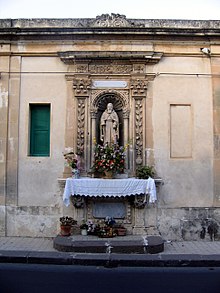تبجيل

تبجيل (لغة لاتينية veneratio، لغة يونانية δουλεία، douleia)، أو تبجيل القديسين، هو عمل خاص لتكريم القديس، وهوالشخص الذي يتميز بامتلاكه قدرًا كبيرًا من القدسية أو القداسة.[1] وتحظى الملائكة بتبجيلٍ مماثل في العديد من الديانات. ولغويًّا، فإن فعل (يبجل) مشتق من الفعل اللاتيني، venerare، ويعني التقدير بشيءٍ من التوقير والاحترام. ويمارس فعل تبجيل القديسين، سواء رسميًّا أو غير رسميٍّ، أنصار بعض مذاهب جميع الديانات الكبرى ومنها المسيحية واليهودية[2] والهندوسية[3] والإسلام[4] والبوذية.[1][3]
ففي المسيحية، تمارس جماعات هذا التبجيل مثل الكنيسة الأرثوذكسية الشرقية، والكنيسة الرومانية الكاثوليكية، والكنائس الكاثوليكية الشرقية، ولكلٍّ من هذه الكنائس درجات متفاوتة من أساليب التقديس أو التمجيد. وفي بعض الطوائف المسيحية، يظهر التبجيل خارجيًّا من خلال الركوع بكل احترام أو عمل علامة الصليب أمام أيقونة قديس، أو أمام قطع أثرية تخصه، أو أمام نصب له، أوعن طريق القيام برحلة حج إلى مواقع ترتبط بقديسين. واعتبرت طوائف معارضة للأيقونات أن ممارسة التبجيل من الهرطقة.
وفي الديانة اليهودية، لا يوجد اعتراف تقليدي أو رسمي بالقديسين، إلا أنه يوجد تاريخ طويل من التوقير للأبطال والشهداء التوراتيين. ومع ذلك يوجد في بعض المناطق، مثل اليهودية في المغرب، تقليد قديم واسع الانتشار لتبجيل القديس.[1][2][3]
أما الهندوسية، فلديها تقليد قديم من تبجيل القديسين، ويُظهر الهندوس هذا التبجيل تجاه غوروات مختلفين ومعلمي القدسية، الأحياء منهم والأموات. وتضم مذاهب بوذية عبادة طقوسية رسمية للقديسين، بالإضافة إلى أن بوذية ماهايانا تصنف درجات من القدسية.[1][3]
أما في الإسلام، فتمارس طوائف مثل طائفة الشيعة والصوفية تبجيل الأولياء، وفي أنحاء كثيرة من جنوب شرق آسيا، إلى جانب «الإسلام الشعبي», والذي يضم في كثير من الأحيان معتقدات وممارسات محلية.[5][6] في حين تمقُت طوائف أخرى هذه الممارسة، مثل أهل السنة والجماعة والوهابيين.[7]
انظر أيضًا
[عدل]ملاحظات
[عدل]- ^ ا ب ج د Lindsay Jones, ed. (2005). Thomson Gale Encyclopedia of Religion (بالطاجيكية) (Second ed.). Macmillan Reference USA. Vol. Sainthood. p. 8033.
- ^ ا ب "Veneration of saints is a universal phenomenon. All monotheistic and polytheistic creeds contain something of its religious dimension... " Issachar Ben-Ami (1998). Saint Veneration Among the Jews in Morocco. Wayne State University Press. ص. 13. ISBN:978-0-8143-2198-0. مؤرشف من الأصل في 2020-02-20. اطلع عليه بتاريخ 2012-09-07.
- ^ ا ب ج د Werner Stark (1966). Sociology of Religion. Taylor & Francis. ص. 367. GGKEY:ZSKE259PDZ9. مؤرشف من الأصل في 2020-02-20. اطلع عليه بتاريخ 2012-09-07.
- ^ Florian Pohl (1 سبتمبر 2010). Modern Muslim Societies. Marshall Cavendish. ص. 294–295. ISBN:978-0-7614-7927-7. مؤرشف من الأصل في 2014-01-05. اطلع عليه بتاريخ 2012-09-07.
- ^ "Sufi Islam". مؤرشف من الأصل في 2018-06-12.
Although frequently characterized as the mystical component of Islam, there are also "Folklorist" Sufis, and the "Traditional" Sufis...Sufism is characterized by the veneration of local saints and by brotherhoods that practice their own rituals.
- ^ "Of saints and sinners: The Islam of the Taliban is far removed from the popular Sufism practised by most South Asian Muslims". The Economist. 18 ديسمبر 2008. مؤرشف من الأصل في 2018-08-29.
In its popular form, Sufism is expressed mainly through the veneration of saints...South Asia is littered with the tombs of those saints. They include great medieval monuments, like the 13th-century shrine of Khwaja Moinuddin Chisti, founder of South Asia's pre-eminent Sufi order, in أجمير. But for every famous grave, there are thousands of roadside shrines, jutting into Delhi's streets, or sprinkled across the craggy deserts of southern Pakistan.
- ^ Kim Murphy (8 مايو 2003). "Saudi Shiites Take Hope From Changes Next Door". مؤرشف من الأصل في 2016-08-21.
while most Sunnis view them as fellow, though possibly misguided, Muslims, Shiites are regarded as infidels by the Saudi religious establishment, which adheres to the ultraconservative and austere variation of Sunni faith known as Wahhabism. Saudi religious leaders see the Shiite veneration of saints and shrines, celebration of the prophet Muhammad's birthday and other rituals as sinful.
((استشهاد ويب)): الوسيط غير المعروف|published=تم تجاهله (مساعدة)
وصلات خارجية
[عدل]- ON THE INVOCATION, VENERATION, AND RELICS, OF SAlNTS, AND ON SACRED IMAGES. Roman Catholic teaching from the Council of Trent (1545–63)
- "Dulia" from the Catholic Encyclopedia (1911)
- a Catholic defense of Latria and Dulia a defense of the Catholic teachings of Latria and Dulia by Catholic apologist William Albrecht who covers the Biblical terms in their religious usage in the Bible
| تبجيل في المشاريع الشقيقة: | |
| |
Text is available under the CC BY-SA 4.0 license; additional terms may apply.
Images, videos and audio are available under their respective licenses.
